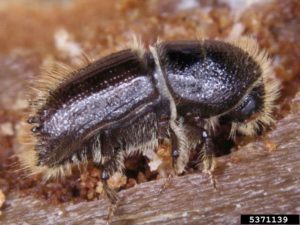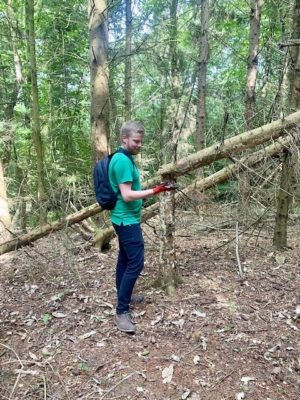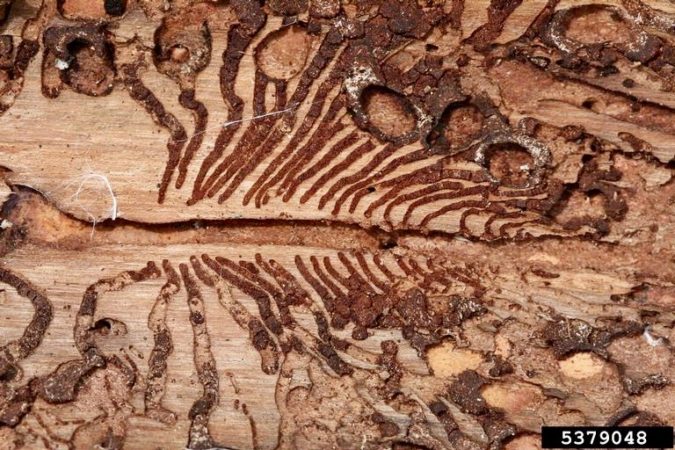Tree Health Pilot Scheme, targeting pests and diseases. Finding out about the THP and SPHNs

We first became aware of the tree health pilot (THP) scheme in 2021 when we received a Statutory Plant Health Notice (SPHN) for trees infected by one of the specified pests. The THP scheme has been designed to help slow the spread of pests and diseases affecting trees in England. There are grants available for larch trees with Phytophthora ramorum, spruce trees affected by Ips typographus, sweet chestnut trees with Phytophthora ramorum or sweet chestnut blight, oak trees with oak processionary moth (OPM) and ash trees with ash dieback.
In our case, the Larger Eight-toothed Spruce Bark Beetle [Ips typographus] had been found in the Norway spruce and we were instructed to fell, move, process and destroy all spruce trees in the defined area of the wood. Strict but clear directions were given regarding the ‘how, when and where’ for the felling and processing. An initial site visit and ongoing support from the Forestry Commission and their Plant Health Forestry Team allowed us to follow the process of applying for a THP grant with ease.
We submitted the application and received confirmation that the grant application was successful, at which point it was over to the team undertaking the felling. Once complete a final inspection from the Forestry Commission took place to ensure we adhered to the agreed method statement (as specified in the SPHN) and then we were able to submit the claim. This claim was processed and received – all within approx. 3 weeks.
Fast forward to 2023.
One of the woods we are managing in the southeast (which lies within the Ips typographus demarcated area) has a small stand of Norway spruce (approx. 0.5 hectare). Some of the trees are damaged, stressed or dead, and at risk of providing the right conditions for the eight-toothed spruce bark beetle. Advice from the Forestry Commission is:
How does felling healthy spruce help the situation? This reduces the opportunity for colonisation [of the beetle] and may sometimes be required as a precaution to ensure that trees that could be potentially infested are removed. Removing spruce as a host from the demarcated area entirely will limit the possibility of populations of Ips typographus establishing and prevent spread to other areas. Predicted climate change means that what is currently healthy spruce may not remain so over future years, hence early felling could reduce the risk of these areas becoming future outbreak sites.
 We decided to investigate whether the THP scheme could support the proactive felling and extraction of the Norway spruce. We submitted an Expression of Interest for the THP scheme, the Forestry Commission undertook a site visit and were able to confirm there was no Ips found in the wood, and we were eligible to apply for the grant. We concurrently applied for a felling licence to clear fell the compartment of Norway spruce. It is worth noting, if an SPHN is served then normally there are no restocking conditions applied however restocking and maintenance grants are available to support restoring woodland In this case there are restocking conditions in line with the felling licence – an opportunity to plant and enable native broadleaves to thrive – that can also be grant-aided. An application for the THP scheme was submitted and we subsequently received a grant offer which was accepted.
We decided to investigate whether the THP scheme could support the proactive felling and extraction of the Norway spruce. We submitted an Expression of Interest for the THP scheme, the Forestry Commission undertook a site visit and were able to confirm there was no Ips found in the wood, and we were eligible to apply for the grant. We concurrently applied for a felling licence to clear fell the compartment of Norway spruce. It is worth noting, if an SPHN is served then normally there are no restocking conditions applied however restocking and maintenance grants are available to support restoring woodland In this case there are restocking conditions in line with the felling licence – an opportunity to plant and enable native broadleaves to thrive – that can also be grant-aided. An application for the THP scheme was submitted and we subsequently received a grant offer which was accepted.
What next?
A pre-felling survey was required in order to determine pest freedom for Ips typographus, and the authorisation for harvesting operations remains valid for 3 months.

Galleries formed by the beetles
An inspection for Ips typographus will need to take place before any felled timber can be taken off site – the advice is to fell and move the timber quickly rather than leaving stacks in the wood. The felling commences this week and should only take 5 days, and we plan to restock with native broadleaves over the winter.
The Forestry Commission has produced a very useful guide Ips typographus: Guidance on the movement restrictions of spruce trees - Forestry Commission (blog.gov.uk) but throughout the whole process the Forestry Commission and Plant Health team have been really supportive and quick to answer queries about Ips, the THP grant scheme and the forestry operations.
My advice if you have a stand of Spruce – is to speak to your Forestry Commission Woodland Officer about getting involved with the Tree Health Pilot scheme or visit their website to find out more: Tree health pilot scheme - GOV.UK (www.gov.uk)
Last week we hosted a number of people from the Forestry Commission, the Plant Health Forestry team, Forest Research, and DEFRA.  They are continually evolving the scheme to understand how best to provide this vital funding to woodland owners to enable and encourage management of spruce and Ips. We were pleased to say they have, however, not found it in the wood!
They are continually evolving the scheme to understand how best to provide this vital funding to woodland owners to enable and encourage management of spruce and Ips. We were pleased to say they have, however, not found it in the wood!

Comments are closed for this post.

Be very careful, as Bill Gates’ tentacles are everywhere. He’s now apparently intent on chopping down 70 million acres of trees in the US, purportedly to fight climate change.
Jan
2 September, 2023